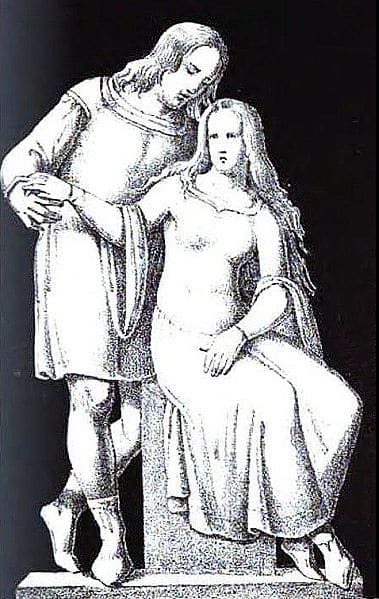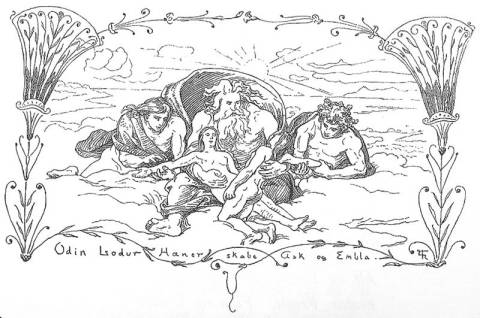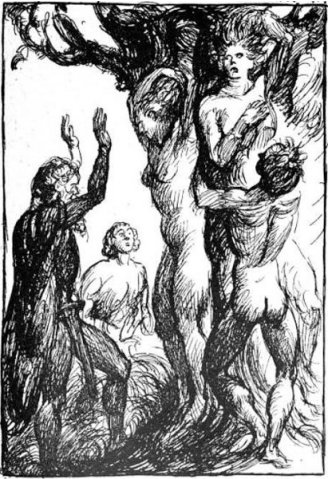In this post, I am diving into the very dawn of humanity, as told through the eyes of the Norse. We’re here to unravel the tale of Ask and Embla (Old Norse ‘Askr ok Embla’), the first humans in Norse mythology.
They are, according to Norse mythology, our shared ancestors. Two pieces of driftwood found on the beach, breathed into life by Odin and his brothers, Vili and Ve. While sharing some similarities with other creation stories, the Norse one is devoid of sin. Humans were simply created and then left to thrive in Midgard.
A Glimpse into Norse Mythology
Norse mythology, the spiritual canvas of the Vikings, is a vibrant mosaic of tales and legends. It’s a realm where gods and giants, elves and dwarves, as well as a plethora of other beings coexist. They all lived side by side, their stories intertwined across nine realms.
At the core of this mythology is the creation myth, a narrative that elucidates the genesis of the cosmos and its inhabitants. Among these beings are Ask and Embla, the first humans, brought to life by the divine trio of Odin, Vili, and Ve.
Norse mythology is not just a collection of stories. It’s a window into the beliefs, values, and worldview of the Vikings. It’s a reflection of their understanding of the universe and their place within it. And at the heart of this understanding is the tale of Ask and Embla. It not only explains humanity’s origins but also prepares the ground for the later three classes of men.
Ask and Embla: The First Humans in Norse Mythology

Ask and Embla hold a unique place in Norse mythology. They are not gods, giants, or mystical creatures. Rather, they are humans, just like us, they are in actuality our shared ancestors. But their origin story is anything but ordinary. They were not born, but created as part of the larger Norse creation myth. They did not emerge from a mother’s womb, but from the raw elements of the natural world. Their story is a testament to the ingenuity and might of the gods, particularly of Odin, Vili, and Ve.
The tale of Ask and Embla is not just about their creation. It’s also about their transformation from mere beings to fully realized humans. It’s a story of how they were endowed with the gifts that make us human. And at the center of this transformation are the gods who shaped them.
The Creation of Ask and Embla

The story of Ask and Embla’s creation is a fascinating one, passed down to us through the ancient texts of the Poetic Edda and the Prose Edda. These are the primary sources of Norse mythology, filled with tales of gods, giants, and the creation of the world. Among these tales is the story of how Ask and Embla came into being.
Specifically, in the poem Voluspa, of the Poetic Edda, the Volva briefly relates the story of Ask and Embla. I should add here that in the Voluspa, Vili and Ve are not mentioned, instead, you find Hoenir and Lodur. However, they are believed to be other names for Odin’s brothers Vili and Ve.
Two verse from the Voluspa reads:
17. Until there came three mighty and benevolent Aesir to the world from their assembly. They found on earth, nearly powerless, Ask and Embla, void of destiny.
18. Spirit they possessed not, sense they had not, blood nor motive powers, nor good color. Spirit gave Odin, sense gave Hoenir, blood gave Lodur, and goodly color.
Born from Ash and Elm
According to the Voluspa then, Ask and Embla were not born, but created. They were fashioned by the gods from the materials they found at hand. Ask was made from an ash tree, and Embla from an elm. More details about the creation is found in the Gylfaginning, part of the Prose Edda, chapter five. If you don’t know the Gylfaginning (Fooling of Gylfi) it was written by Snorri Sturlusson and in its narrative he recounts major parts of Norse mythology. In its chapter five, the creation Ask and Embla is retold.
Then said Ganglere: Much had been done, it seemed to me, when heaven and earth were made, when sun and moon were set in their places, and when days were marked out; but whence came the people who inhabit the world?
Har answered as follows: As Bor’s sons went along the sea-shore, they found two trees. These trees they took up and made humans of them. The first gave them spirit and life; the second endowed them with reason and power of motion; and the third gave them form, speech, hearing and eyesight.
They gave them clothes and names; the man they called Ask, and the woman Embla. From them all mankind is descended, and a dwelling-place was given them in Midgard. In the next place, the sons of Bor made for themselves in the middle of the world a fortress, which is called Asgard.
The Gifts Bestowed Upon Ask and Embla
The creation of Ask and Embla was only the beginning of their story. Once their forms were crafted, the gods bestowed upon them three gifts. These gifts transformed Ask and Embla from mere forms to fully realized humans. They were the gifts of breath, consciousness, and appearance.
Each of these gifts was given by a different god. Odin, the Allfather, gave them breath. Vili gave them consciousness, the ability to think and feel. And Ve gave them appearance, the physical form that we recognize as human. These gifts were not just physical attributes. They were the essence of what it means to be human.
It’s also probably a good reflection of how the Norse saw themselves. They were beings with a living body, that then conversely could die, and they had a strong sense of self. In separating them, they might also be allowed to “live on” in a different realm, when their living body perishes.
Theories and Interpretations
The story of Ask and Embla has been the subject of much debate and interpretation. Some see it as a simple creation story, similar to those found in many other cultures. Others see deeper meanings and symbolism in the tale.
They were created from driftwood trees, but why these particular trees? The names Ask and Embla do hold some clues. Askr is Old Norse for ‘ash tree’, while Embla could be related to ‘elm’, which in Old Norse is almr. However, that is less certain than the Askr connection to tha ash tree. Moreover, as you possibly know, the ash tree holds a central position in Norse mythology. The Yggdrasil, the cosmic tree that holds all the nine realms together, is in fact a giant ash tree.
There are those who draw parallels with the biblical story of Adam and Eve, while others see echoes of ancient Proto-Indo-European myths.
One of the most intriguing theories is the Proto-Indo-European basis for the duo. This theory suggests that the story of Ask and Embla has roots in a much older tradition, one that predates the Vikings and even the Norse. It’s a theory that opens up a whole new dimension to the tale, connecting it to a broader tapestry of human mythology.
Ask and Embla compared to other creation myths
The story of Ask and Embla in Norse mythology shares several commonalities with other creation myths around the world. These similarities might suggest a shared cultural heritage or influence, or they might reflect universal human concerns and ways of understanding the world.
Adam and Eve in Judeo-Christian Mythology
The most obvious comparison is with the story of Adam and Eve from the Bible. Like Ask and Embla, Adam and Eve were the first humans, created by God. Adam was formed from the dust of the ground, much like Ask was formed from an ash tree. Eve was created from Adam’s rib, a detail that, while not directly parallel to Embla’s creation from an elm tree, does share the theme of humans being created from existing material rather than being born in the usual way.
However, there are also significant differences. The story of Adam and Eve includes the concept of original sin, which is absent from the Norse myth. Furthermore, the Norse gods gave gifts to Ask and Embla, enhancing their abilities, while in the Judeo-Christian tradition, God punishes Adam and Eve for their disobedience.
Pandora in Greek Mythology
In Greek mythology, Pandora was the first woman, created by the gods from clay. Each god gave her a gift, similar to the gifts given to Ask and Embla. However, Pandora’s story has a darker ending. She was given a box (or jar) and told not to open it, but curiosity got the better of her. When she opened the box, all the evils of the world flew out, leaving only hope inside.
The Pandora myth shares with the Ask and Embla story the theme of the first woman being created by the gods and receiving gifts from them. However, the Pandora story serves as a kind of cautionary tale about curiosity and disobedience, which is not a theme in the Ask and Embla story.
Deucalion and Pyrrha in Greek Mythology
Another Greek myth, the story of Deucalion and Pyrrha, has some similarities with the Ask and Embla myth. After a great flood, Deucalion and Pyrrha are the only humans left. They ask the goddess Themis for advice, and she tells them to “throw the bones of their mother” over their shoulders. They interpret this to mean they should throw stones (the bones of Mother Earth) over their shoulders, and the stones turn into people, repopulating the earth.
This story shares with the Ask and Embla myth the theme of humans being created from elements of the earth. However, the context is different: Deucalion and Pyrrha are repopulating the earth after a disaster, while Ask and Embla are the first humans.
These comparisons show that while the Ask and Embla myth has unique elements, it also shares themes with other creation myths. This could suggest a common origin, or it could reflect universal human concerns and ways of understanding the world.
Ask and Embla in the Context of Norse Society

The story of Ask and Embla was more than just a creation myth for the Norse. It was a narrative that shaped their understanding of the world and their place within it. Moreover it influenced their social relations, their beliefs, and their values. It was a story that was woven into the fabric of their society.
Ask and Embla were seen as the progenitors of all humans, the ancestors of every man and woman. They were a symbol of the shared humanity of the Norse people, a reminder of their common origins. This sense of shared ancestry may have played a role in the strong sense of community and kinship that was characteristic of Norse society.
Rigsthula and the Classes of Man
But the Norse society was not a homogenous entity. It was divided into different classes, each with its own role and responsibilities. This class structure is reflected in another Norse myth, the story of the god Rig, as told in the Rigsthula, a poem in the Poetic Edda.
According to the Rigsthula, Rig, who is often identified as Heimdall or possibly as Odin, fathered the different classes of men. He visited three couples and stayed with each for three nights. From these visits, three sons were born: Thrall, the ancestor of slaves; Karl, the ancestor of free peasants; and Jarl, the ancestor of the nobility.
This story, like the tale of Ask and Embla, speaks to the Norse understanding of humanity. But while Ask and Embla represent the common origin of all humans, the story of Rig speaks to the diversity of human society. It reflects the Norse understanding of social hierarchy and the division of labor.
The tales of Ask and Embla and Rig together provide a comprehensive view of humanity in Norse society. They speak to the shared origins of all humans, as well as the diversity and hierarchy within human society. They reflect the Norse understanding of the world and their place within it, and they continue to resonate with us today as we explore our own understanding of humanity and society.
FAQs
Ask and Embla are the first humans in Norse mythology. They were created by the gods Odin, Vili, and Ve from an ash tree and an elm tree, respectively.
The gods bestowed three gifts upon Ask and Embla: breath, given by Odin; consciousness, given by Vili; and appearance, given by Ve.
Like many creation myths, the story of Ask and Embla explains the origins of humanity. However, it’s unique in its details, such as the creation of humans from trees and the specific gifts bestowed by the gods.
The story of Ask and Embla is found in the Poetic Edda and the Prose Edda, the primary sources of Norse mythology.
Last thoughts on Ask and Embla
A fun fact might be that both Ask and Embla are popular names in both Norway and Sweden today. While Ask has been held steady for a long time, Embla has actually gained in popularity in the last couple of decades. This might mirror an increasing fascination and connection with the Old Norse past in Norwegian and Swedish society.
The story of Ask and Embla is a captivating tale that delves into the very roots of humanity. It’s a narrative that has shaped the Norse understanding of the world, influenced their society, and continues to inspire and fascinate to this day.
As we explore the tale of Ask and Embla, we’re not just uncovering the origins of humanity in Norse mythology. We’re also delving into the timeless questions of who we are and where we come from, questions that continue to resonate with us today.
Featured Image Credit: Lorenz Frølich, Public domain, via Wikimedia Commons
